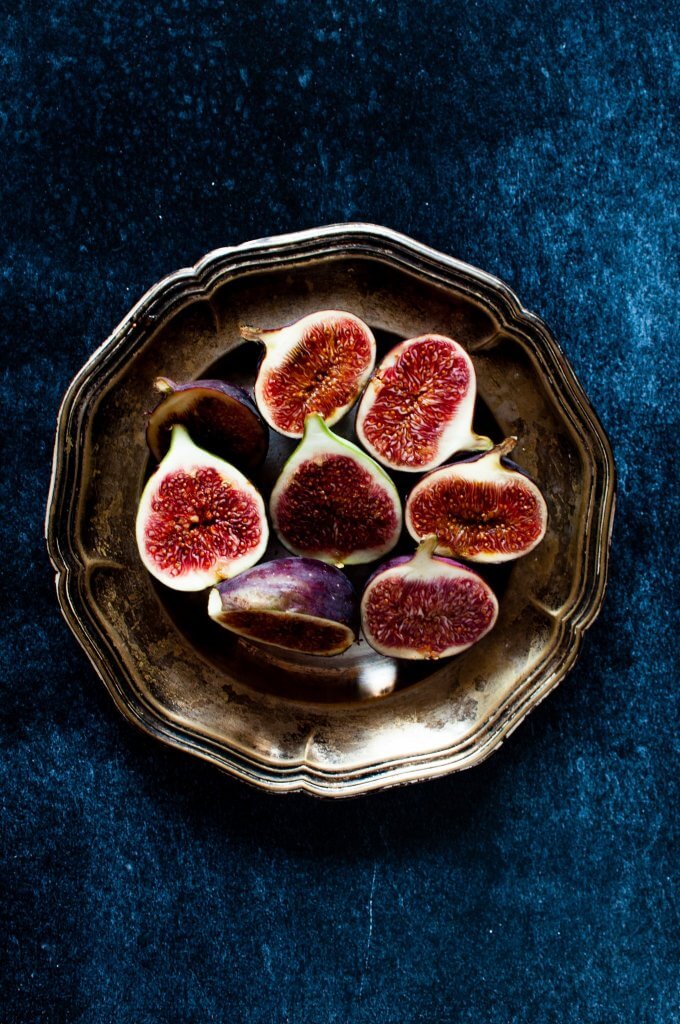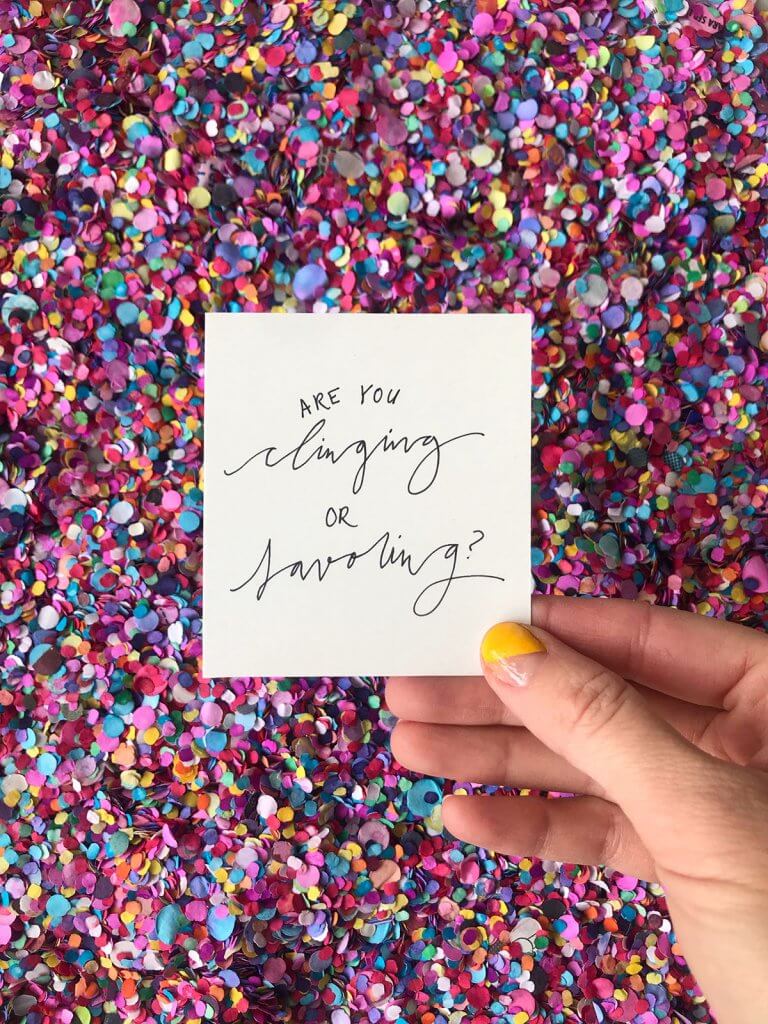Are you clinging or savoring?

It started with a fig tree. It was late and I was driving, and the Robcast episode “We have a fig tree” caught my attention. (Have you ever listened to Rob Bell’s podcast? I turn to it when I’m craving something philosophical and reflective. He’s a pastor, so there’s a good dose of spirituality in there too, but it’s not religious in a preachy way. Rather, Bell shares ideas about life and mines old and new testament verses for what relevance these characters and stories and symbols have to our modern lives.)
Anyway, in the episode, Rob and his wife Kristen are discussing the joy of having a fig tree. Figs are evanescent. It’s hard to get good ones at the market because they don’t last long off the tree, so to have one growing in your yard is an experience of sudden and fleeting abundance.
And this is a lot like life. Joy comes out of nowhere, filling up moments until you feel like they could burst. And you know it won’t always be this way, so the temptation is to want to soak up as much as possible. Which leads to a question…
How best to appreciate these delicious, yet impermanent moments?
A natural response is to try to cling to them, to hold tight and not let go. Rob’s wife, Kristen, describes a feeling many parents will find familiar: the desire to hold on to certain stages when her children were very young. “Even in my body I could just feel myself wanting to grasp onto something that can’t be held,” she says.
There’s a poignancy to that ache, and this feeling can sometimes be a tender awareness of the passage of time, like what the Japanese might call mono no aware, “the gentle sadness of things,” often used to describe a reaction to evanescent joys like the cherry blossoms. But when we cling to a moment, we go beyond wishing a moment might last longer to feeling regretful or sad that it can’t. And this can start to overwhelm our joy.
One way that clinging manifests is holding on past the point of joy. We all know that friend who won’t let anyone go home because they just want the party to keep going, long after everyone else has stopped having fun. Many of us have stayed in a job or a relationship past the point when we knew we should’ve left, simply because we were holding on to memories of earlier good times that no longer reflect our daily experience.
In addition to keeping us holding on, clinging can also make us hold back. There’s a fine line between feeling the bittersweetness of watching a child grow and finding it hard to be fully present with our joy because we’re bringing so much sadness and grasping into the moment. When our great joys start to feel more like losses, it’s a sign that we’re fighting time in a way that is hindering our joy.
As Rob Bell says, “It’s like this awareness that there’s this moment, and it’s going to pass. And you can allow the sadness of its impermanence to creep in: ‘Oh no, we’re gonna lose this.’ Or you can simply allow that impermanence to heighten the joy.”
Enter savoring
This alternative, allowing impermanence to heighten joy, sounds a lot like savoring, a behavior known in the positive psychology literature to increase both momentary joy and overall happiness and well-being. Savoring helps us absorb the joy we feel, take it deep into our souls, making it a part of us. When we savor, we acknowledge our gratitude for an experience, we intensify the pleasure of it, and we etch it deep into our memories so that we can call this joy back at a later date.
A rich model for savoring comes from researchers Fred B. Bryant and Joseph Veroff, who suggest a range of strategies we can deploy to savor a moment. (I talked about a number of these in depth with time expert Laura Vanderkam in our conversation for the Joy Makeover, which you can watch here.)
- Sensorial awareness: Taking note of specific enjoyable sensations, particularly ones that are often overlooked such as textures, sounds, or scents, can help make your physical experience more dimensional.
- Social appreciation: Sharing your joy aloud with others, celebrating, and appreciating that you can be together for this experience not only helps you internalize the joy of the experience, but it can also deepen your relationships.
- Recalling obstacles: If you experienced hardship on the way to this joyful moment, bringing that struggle back to mind can increase your appreciation for it. For example, when I’m on a date night with my husband, Albert, I sometimes think about how long it took for us to meet, and how many terrible dates I had to go on before we got together. Or if you grew up in poverty, the moment of receiving a first paycheck at a job might be made sweeter by recalling your family’s struggle.
- Slowing down: Taking your time through an experience can give your mind and senses time to absorb as much as possible.
What these strategies have in common is that they expand the present moment. They give you more space for your joy.

Why it matters
This distinction between clinging and savoring can be subtle, but it really hit home to me when Bell started talking about these behaviors as it relates to faith. He describes clinging as a manifestation of a particular fear, “a scarcity which doesn’t believe that the universe can continue to generate moments of equal or greater meaning and power and joy. Can it keep generating new creation?” he asks, “Or are you left grasping and trying to stuff your pockets full of these little stones from way back there.”
Whether you see it in terms of faith or in terms of worldview, at root, clinging is a product of a scarcity mindset. It’s a belief that joy is limited, that there’s very little of it to go around, and that you never know when, or if, you’ll get more of it. Savoring, on the other hand, is the manifestation of an abundance mindset. Savoring acknowledges that joy is fleeting, but seeks to capture as much of it as possible, while trusting that joy will come back again. As Kristen says about those moments with her kids, “I started to notice that whenever they passed into a new stage, there were all these new joys and experiences that I had never anticipated. And I never wanted to go back to the old stage…. I could fully enjoy this stage, and then I could fully enjoy the next stage, and it was all going to be ok.”
This is so important because if I’ve learned anything over the last few years, it’s that pretty much anything good can be ruined by a scarcity mindset. Bring a scarcity mindset to friendships, and things start to feel competitive. Take a scarcity mindset in creative work, and it’s easy to convince yourself that all the good ideas are taken and there’s nothing left for you. Scarcity mindset in business? It practically ensures that you’ll focus so much on your competition that you stop producing anything original. Scarcity mindset with food? Each craving you deny will feel like deprivation, creating an overwhelming desire to binge.
This isn’t just a philosophical perspective. Psychologists who study scarcity have found that it creates a kind of tunnel vision, a stressed-out state that leads us to make irrational decisions that run counter to our interests. People living in poverty mismanage money not because they don’t know better, but because the awareness of its scarcity alters their decision-making. People who face a scarcity of time also tend to make poor decisions about how to allocate it. The same goes for lonely people who feel an acute scarcity of social connections. Scarcity is a perception of lack, and when we are coming from a place of lack, there’s no amount of joy that will fill that hole.
From a spiritual lens, Rob says, “This is all rooted in how we understand creation, the world we’re living in. Is it capable of continuing to create more? And can we enter and participate in that ‘more’? Or are we stuck just endlessly looking back to these idealized moments in the past?” (Again, you don’t need to be spiritual to resonate to this notion. Replace “creation” with “life” and to me the meaning is the same.)
When we cling, not only do we shrink the present, but we get stuck in the past. Insisting that the best days of your life were in high school is a form of clinging. Longing for the honeymoon period of your relationship is clinging.
The problem with this is that clinging abdicates your responsibility for creating joy in your own life right now. What is stopping you from making this next year the best of your life so far? What is stopping you from loving your partner like you’ve just met?
Only this: the belief that joy is limited, and that you don’t have any hand in creating it.
This is why it’s so important to me that everyone understand that joy is something that can be created, and that there are tools anyone can learn to use to notice, savor, craft, and share more joy, every day.
Knowing this reminds us how important it is to approach our joy through a lens of abundance. When we trust that there is enough to go around, that there will be more, it liberates us from the need to cling. We’re free to allow ourselves the vulnerability to embrace the full height of our joy, trusting that there will be new joys in the future, ones that we cannot even dream of, that will transform us in ways we cannot imagine.
Header image: Magdalena Raczka via Unsplash





Discussion (12 Comments)
I had such a rich experience reading this post.
I’m very new to your work and enjoyed so much you sharing your knowledge and experience and particularly how you found lots of little asides to bring in to add flavour and texture.
I experienced a very rich and satisfying read and having a feeling if upliftment. A post with perfect timing.
Thank you
Andy
Thank you for your kind words, Andy. It means a lot to hear that this post resonated with you in this way!
Love this post, Ingrid. Resonates deeply with my life experiences. Well written. Also, have listened to almost all of the joy makeover posts. There are gems in every one. Thank you for all the work that went into choosing the people you interviewed and the work of interviewing itself. That is its own skill! And I really appreciate that you put them up for no cost to us listeners. It was a generous thing to do and speaks to your abundance mindset. As we say in Hawaii, mahalo.
Mahalo, Rebecca! I appreciate the kind words and acknowledgment, and I’m thrilled that you liked the Joy Makeover!
Thanks for this great piece. It’s such an important lesson and you frame it so well. I find that I sometimes need reminders to take me away from a scarcity mindset and dwell in the land of abundance. This was a very helpful reminder!
Thank you, Fran. I’m so glad it was helpful to you!
This is the first of your posts that I have read. I found helpful wisdom particularly on how to savor joyful moments while also releasing them in due time without fear that they will be the last! Thank you!
Karen, thanks for your kind words and welcome to the Aesthetics of Joy! It brings me joy to know this post resonated with you!
I have several fig trees. I love fresh figs, but the squirrels love them too and eat them before I get a chance to let them ripen. But I get joy from knowing I have fig trees and happy squirrels! On a serious note, living in the moment is the best way to savor the experience. I have found that there are always more and varied moments to savor. If you cling to the past, you’ll miss them.
Kelly, this is lovely. I’m so glad you are able to find joy in your squirrels’ joy! To living in the moment!
This summer I read a William Blake poem that revolutionized my thinking on this. I have *always* been a clinger, likely ever since my sister died at birth. I’ve always been eager for new things but afraid to let go of good things. It’s always been wrapped up with grief for me. This shift has been revolutionary in my way of living in the world. Here’s the poem: He who binds to himself a joy/ Doth the winged life destroy; /But he who kisses the joy as it flies/ Lives in eternity’s sunrise.”
Susan, thank you for this beautiful comment and for sharing this William Blake version. It’s such a beautiful reminder, and I’m so glad to hear of the effect it’s had on you and your joy!